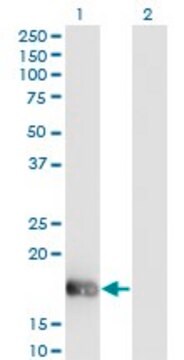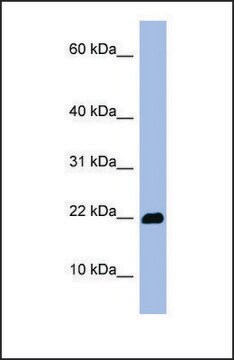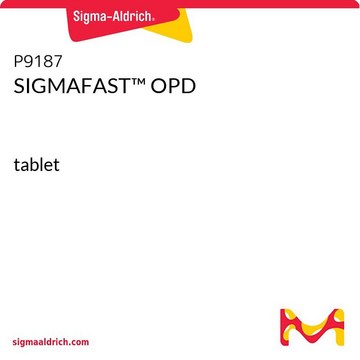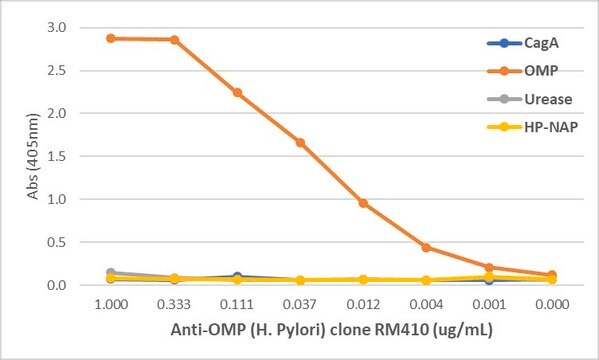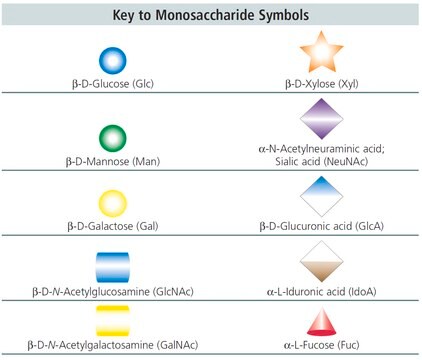추천 제품
생물학적 소스
rabbit
Quality Level
결합
unconjugated
항체 형태
affinity isolated antibody
항체 생산 유형
primary antibodies
클론
polyclonal
양식
buffered aqueous solution
분자량
antigen ~19 kDa
종 반응성
rat, mouse
농도
~2 mg/mL
기술
western blot: 0.5-1.0 μg/mL using rat brain (olfactory bulb) extract (S1 fraction).
UniProt 수납 번호
배송 상태
dry ice
저장 온도
−20°C
타겟 번역 후 변형
unmodified
유전자 정보
rat ... Omp(24612)
관련 카테고리
일반 설명
Olfactory marker protein (OMP) is a phylogenetically conserved cytoplasmic protein of unknown function expressed almost exclusively in mature olfactory sensory neurons, in essentially all vertebrate species. OMP is expressed in both the olfactory neuroepithelium and the olfactory nerve projection to the olfactory bulb. In perikaryon, OMP is produced and are transported to the dendrite and axon in the glomerular layer of the olfactory bulb.
Olfactory marker protein (OMP) is a phylogenetically conserved, 19kDa, cytoplasmic protein of unknown function expressed almost exclusively in mature olfactory sensory neurons, in essentially all vertebrate species. The gene encoding OMP is localized on rat chromosome 1. OMP expression is initially detected in rat and mouse embryo during the last trimester of gestation and reaches adult levels at 2-4 weeks postnatally. It has been suggested that OMP is a novel modulatory component of the odor detection signal transduction cascade that is developmentally and physiologically regulated.
면역원
synthetic peptide corresponding to amino acids 119-137 located near the C-terminus of rat OMP conjugated to KLH.
애플리케이션
Anti-OMP antibody produced in rabbit has been used in immunohistochemistry.
Anti-OMP antibody produced in rabbit has been used in:
- immunoblotting
- double immunofluorescence
- staining
생화학적/생리학적 작용
Olfactory marker protein (OMP) helps to modulate the formation and refinement of the olfactory glomerular map. OMP-deficient mice generated by gene targeting in embryonic stem (ES) cells are compromised in their ability to respond to odor stimuli. In the OMP-null mouse, in addition to reduced odorant response, the levels of neural tyrosine hydroxylase (TH) and neuropeptide cholecystokinin (CCK) are severely reduced. It has been suggested that OMP is a novel modulatory component of the odor detection signal transduction cascade that is developmentally and physiologically regulated.
물리적 형태
Solution in 0.01 M phosphate buffered saline, pH 7.4, containing 15 mM sodium azide.
면책조항
Unless otherwise stated in our catalog or other company documentation accompanying the product(s), our products are intended for research use only and are not to be used for any other purpose, which includes but is not limited to, unauthorized commercial uses, in vitro diagnostic uses, ex vivo or in vivo therapeutic uses or any type of consumption or application to humans or animals.
적합한 제품을 찾을 수 없으신가요?
당사의 제품 선택기 도구.을(를) 시도해 보세요.
Storage Class Code
10 - Combustible liquids
WGK
WGK 3
Flash Point (°F)
Not applicable
Flash Point (°C)
Not applicable
개인 보호 장비
Eyeshields, Gloves, multi-purpose combination respirator cartridge (US)
가장 최신 버전 중 하나를 선택하세요:
Expression of CD36 by olfactory receptor cells and its abundance on the epithelial surface in mice
Lee S, et al.
PLoS ONE, 10(7), e0133412-e0133412 (2015)
Diverse populations of intrinsic cholinergic interneurons in the mouse olfactory bulb
Kurt K
Neuroscience, 161-178 (2012)
Olfactory marker protein (OMP) gene deletion causes altered physiological activity of olfactory sensory neurons
Buiakova OI, et al.
Proceedings of the National Academy of Sciences of the USA, 93(18), 9858-9863 (1996)
Backbone dynamics of the olfactory marker protein as studied by 15N NMR relaxation measurements.
Biochemistry, 44(28), 9673-9679 (2005)
Olfactory marker protein (OMP) gene deletion causes altered physiological activity of olfactory sensory neurons.
Proceedings of the National Academy of Sciences of the USA, 93(18), 9858-9863 (1996)
자사의 과학자팀은 생명 과학, 재료 과학, 화학 합성, 크로마토그래피, 분석 및 기타 많은 영역을 포함한 모든 과학 분야에 경험이 있습니다..
고객지원팀으로 연락바랍니다.